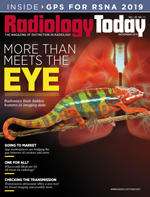 Editor’s Note — That Time of Year Again
Editor’s Note — That Time of Year Again
By Dave Yeager
Radiology Today
Vol. 20 No. 11 P. 4
It’s once again the time of year when many in the radiology community will be simultaneously packing for RSNA and digesting their Thanksgiving meal. Thanksgiving and RSNA serve as the unofficial beginning of the winter holiday season, and the conference, though typically hectic, offers a glimpse of some possibilities to look forward to in the new year. To help make sense of the bustle, this issue includes our annual guide to what’s notable and interesting in the halls of McCormick Place. We also have some articles that may pique your interest.
In this month’s cover feature, Dan Harvey looks at the state of radiomics. Radiomic algorithms are able to find patterns in imaging data that aren’t evident to humans. Researchers are using the algorithms to not only extract quantitative information from standard imaging exams but also predict treatment response of cancerous nodules. Many in the field believe that radiomic techniques will be applicable to medical conditions beyond cancer and may help to enable personalized medicine.
It seems as though technological progress is accelerating faster than ever, and this is especially apparent in the use of AI. One drawback to AI apps, however, is that they are narrowly focused on identifying specific imaging features. To help radiologists more conveniently find apps that they can use, marketplaces are evolving to connect app developers with radiologists. Kathy Hardy reports on the growth of some of these marketplaces and what the future may hold.
And, with all the talk about Medicare for All in the air, have you given any thought to how that type of change in our health care system might affect radiology? Beth W. Orenstein interviews some experts to get a better read on the good and bad aspects of such a monumental shift. Whether it ever comes close to being implemented is still highly uncertain, but it’s probably not a bad idea to consider what could happen, just in case. Get the details on page 22.
Another interesting technology that may find wider use is transmission ultrasound. Currently FDA cleared as an adjunct to mammography, transmission ultrasound uses multiple detectors to improve spatial resolution. The method has shown promise for evaluating dense breast tissue, and investigators are testing it to see where else it may be useful. Keith Loria provides the specifics.
Finally, if you happen to be at RSNA, please stop by Radiology Today’s booth, #3255 in the South Hall, and say hello. And be sure to enjoy Chicago’s attractions, holiday decorations, and, of course, its signature pizza. I hope to see you there.
Enjoy the issue and the show.

